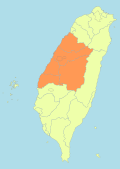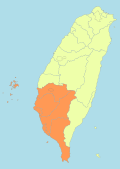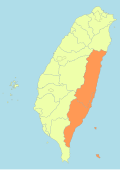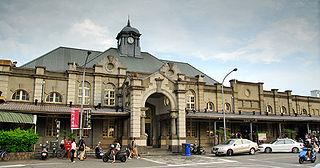
Taiwan Province is a nominal administrative division of the Republic of China (ROC). Its definition has remained part of the Constitution of the Republic of China, but the province is no longer considered to have any administrative function practically.

The Legislative Yuan is the unicameral legislature of the Republic of China (Taiwan) located in Taipei. The Legislative Yuan is composed of 113 members, who are directly elected for 4-year terms by people of the Taiwan Area through a parallel voting system.
The Republic of China (Taiwan) is divided into multi-layered statutory subdivisions. Due to the complex political status of Taiwan, there is a significant difference in the de jure system set out in the original constitution and the de facto system in use today.

The Constitution of the Republic of China is the fifth and current constitution of the Republic of China (ROC), ratified by the Kuomintang during the Constituent National Assembly session on 25 December 1946, in Nanjing, and adopted on 25 December 1947. The constitution, along with its Additional Articles, remains effective in ROC-controlled territories.
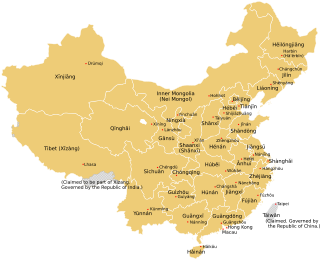
The provincial level administrative divisions are the highest-level administrative divisions of China. There are 34 such divisions claimed by the People's Republic of China, classified as 23 provinces, five autonomous regions, four municipalities and two special administrative regions. The political status of Taiwan Province along with a small fraction of Fujian Province remain in dispute; those are under separate rule by the Republic of China, which is usually referred to as "Taiwan".

The Judicial Yuan is the judicial branch of the government of the Republic of China on Taiwan. It runs a Constitutional Court and oversees all systems of courts of Taiwan, including ordinary courts like the supreme court, high courts, district courts as well as special courts like administrative courts and disciplinary courts. By Taiwanese law, the Judicial Yuan holds the following powers:

The Control Yuan is the supervisory and auditory branch of the government of the Republic of China (Taiwan).
In Taiwan, parliamentary elections are held every four years to elect the 113 members of the Legislative Yuan, the unicameral legislature of Taiwan. The current electoral system was introduced in 2008. The constitutional amendments of 2005 extended term length from three to four years, reduced seat count from 225 to 113, and abolished the National Assembly, originally another governmental organ equivalent to a chamber of parliament.

Taihoku Prefecture was an administrative division of Taiwan created in 1920, during Japanese rule. The prefecture consisted of modern-day Keelung, New Taipei City, Taipei and Yilan County. Its government office, which is now occupied by the Control Yuan of Taiwan, was in Taihoku City.
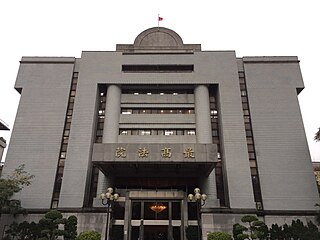
The Supreme Court of the Republic of China is the court of last resort in the Republic of China (Taiwan), except matters regarding interpretation of the Constitution and unifying the interpretation of laws and orders which are decided by the Constitutional Court of the Judicial Yuan.
Same-sex marriage between citizens became legal in Taiwan on 24 May 2019, making Taiwan the first state in Asia to legalize same-sex marriage. Marriages between Taiwanese and foreign citizens were initially restricted to citizens of countries that also recognized same-sex marriage. That limitation was rescinded on 19 January 2023. The one remaining exception is citizens of mainland China, because cross-straits marriages must be registered in mainland China before they can apply in Taiwan. Taiwanese same-sex marriage legislation does not cover joint adoption if the child is not genetically related to the couple, though one instance was approved by a local court in 2022.

The 1st Legislative Yuan election was held in China between 21 and 23 January 1948. This election, and the preceding 1947 National Assembly election are the first elections of under the newly ratified 1947 Constitution of the Republic of China. Under this constitution, the Legislative Yuan is a standing legislature when the National Assembly is not in session. At the time most of Chinese territory was under the control of the government of the Republic of China, using a direct voting system elected 759 Legislative Representatives. Using the Republic's then 461 million population to calculate, on average 600,000 people elected one representative in the Legislative Yuan. The election along with the one held for the National Assembly also made China the largest democracy at the time.

The Ministry of Justice is a ministerial level governmental body of the Republic of China (Taiwan), responsible for carrying out various judicial functions.
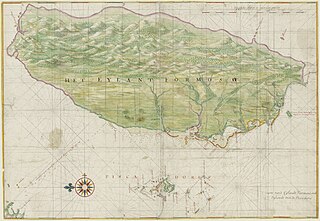
The recorded history of Taipei began with the Han Chinese settling of the Taipei Basin in 1709, leading up to the formation of the national capital of Taiwan and high-tech industry hub and that is now Taipei City. Other notable dates include the 1895 annexation of Taiwan by Japan, during which Taipei began to grow more rapidly, and in the 1950s, the USA's provision of financial assistance to the Republic of China government, after which the city continued on a path of fast structural and industrial growth.
The law of the Republic of China as applied in Taiwan, Penghu, Kinmen and Matsu is based on civil law with its origins in the modern Japanese and German legal systems. The main body of laws are codified into the Six Codes:
The district courts are the ordinary trial courts of general jurisdiction under the law of Taiwan. Currently there are 22 district courts under the jurisdiction of the Republic of China (Taiwan).
Districts are administrative subdivisions of the Republic of China (Taiwan)'s special municipalities of the second level and provincial cities of the third level formerly under its provinces. There are two types of district in the administrative scheme.
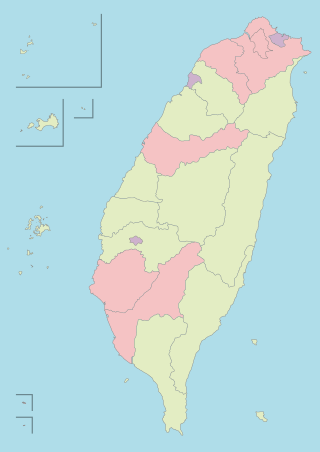
Special municipality, historically known as Yuan-controlled municipality is a first-level administrative division unit in the Republic of China (Taiwan). Under the administrative structure of Taiwan, it is the highest level of division in Taiwan and is equivalent to a province. Since the streamlining of provinces in 1998, the special municipalities along with provincial cities and counties have all governed directly under the central government.

Su Jia-chyuan is a Taiwanese politician of the Democratic Progressive Party (DPP).
The administrative divisions of China between 1912 and 1949 were established under the regime of the Republic of China government.

